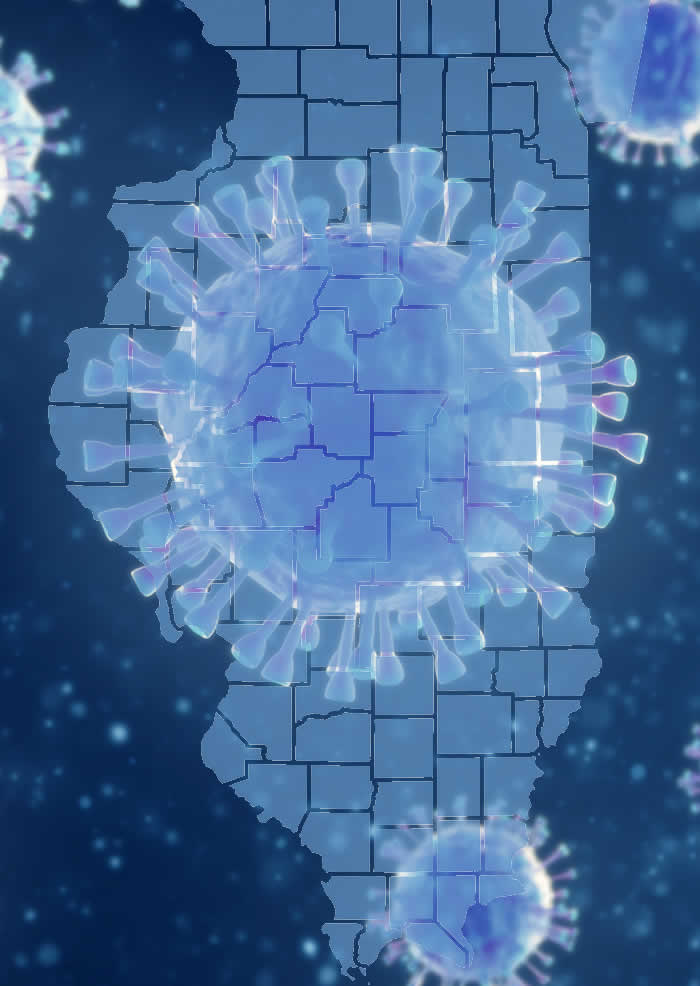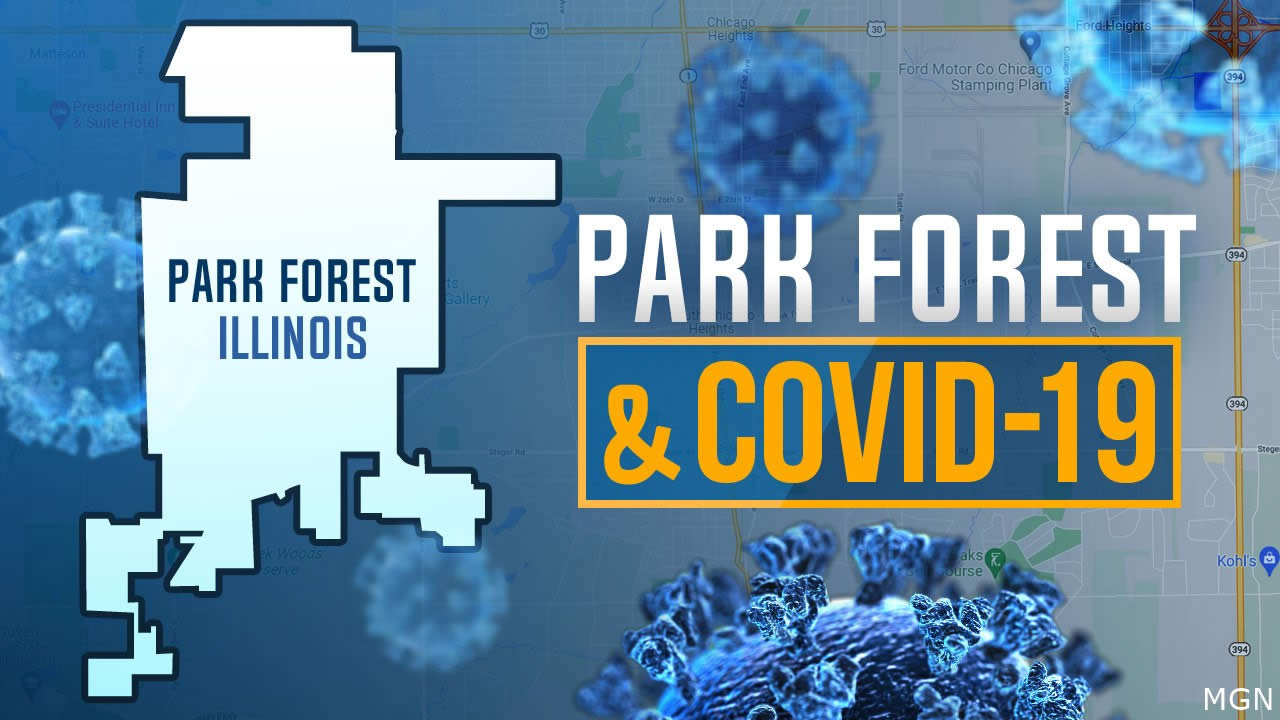
Park Forest, IL-(ENEWSPF)- Figures from the Office of the Cook County Medical Examiner show a continued decline, or a least a tapering, of deaths per day in the 30 towns eNews Park Forest continues to track. Park Forest and Chicago Heights, however, each lost one more person to the pandemic than when we last surveyed on July 10. Orland Park, South Holland, and Tinley Park also lost one more person each to COVID-19, but that is all if that counts as good news.
South Chicago Heights remains the only one of the 30 towns we track that has not lost a single person to COVID-19.
Cases in general continue to rise. Park Forest has 546 cases and a rate of 2547.95 per 100,000, Chicago Heights 697 and a rate per 100k of 2302.15, and Cicero leads the pack with 3157 and the highest rate of the 30 still at 3763.31, this despite Cicero’s large population of almost 84,000 people.
The overall recovery rate in Illinois has improved from 94% to 95% since we last surveyed. We have no data on how many people are suffering lingering effects of COVID nor does anyone know yet if some conditions those have since recovering will become chronic.
That’s yet another problem with this disease: there is so much we still don’t know.
It is now clear that those who survive COVID-19 may suffer a relapse or become reinfected.
However, the Institute for Health Metrics and Evaluation (IHME), an independent global health research center at the University of Washington, now predicts upwards of 224,546 people in the United States will die of the virus by November 1, 2020. In Illinois, the number is forecasted to be 8,351, and 3,632 deaths in Indiana. The number for Illinois is somewhat lower than the forecasted 8,907 when we checked last, another welcome improvement.
According to the state of Illinois, Ludeman Center in Park Forest has 230 residents who tested positive for COVID-19, up from 223 when we last surveyed. Of these 230 residents who tested positive, 222 have recovered. That’s seven more recovered residents since we last checked.
A total of 129 staff members at Ludeman have tested positive, three more since we last surveyed. However, of these, 119 have recovered and returned to work, one more than when we last surveyed.
As of July 20, three Ludeman Homes are quarantined for droplet isolation, up from none when we last surveyed. This refers to precautions healthcare workers, visitors, and staff need to take “before going into or leaving a patient’s room.” These three homes are not available for in-person visits, Parents & Friends of the Ludeman Center report. “All other Unit 3 homes are cleared for in-person visits,” the group reports.
“Droplet precautions are for patients who have germs that can spread when they cough or sneeze.” (MyHealth.Alberta.CA)
Ludeman Center employs 911 people and has 339 residents, according to the current census. All have been tested, some twice, according to Parents & Friends. Staff continues to undergo wellness checks before reporting to their respective assignments, the group Parents & Friends reports.
A total of 4,852 people in Park Forest have been tested with an overall positive test percentage of 11.25%, down from 12.30% when we last surveyed.
The Will County Health Department reports 48 cases of COVID-19 in the Will County section of Park Forest as of July 20, 2020. That figure is four higher since we last surveyed.
As of this writing, Chicago Heights has 97 confirmed cases and a rate of 2302.15 per 100k. Steger has 109 cases, Flossmoor 111, Richton Park 247, Olympia Fields has 70, Sauk Village 137, Glenwood 202, Tinley Park 415, and South Chicago Heights has 104.
Harvey has 553 cases, Country Club Hills has 391 cases, Orland Park 645, Lynwood 156, Lansing 496, Homewood 314, South Holland 521, Markham 253, and Crete 208.
Ford Heights now has 40 cases, and Calumet City has 747 and a rate of 2016.63 per 100,000 people.
Currently, IDPH is reporting a total of 162,748 cases, including 7,301 deaths, in 102 counties in Illinois. The age of cases ranges from younger than one to older than 100 years. Within the past 24 hours, laboratories have reported 34,598 specimens for a total of 2,279,109. The preliminary seven-day statewide positivity for cases as a percent of total test from July 13 – July 19 is 3.0%.
As of last night, 1,410 people in Illinois were reported to be in the hospital with COVID-19. Of those, 308 patients were in the ICU and 133 patients with COVID-19 were on ventilators.
As of July 20, 2020, there are a total of 38,906 confirmed cases of COVID-19 in suburban Cook County and 1,760 deaths; only 178 cases are in congregate settings, such as long term care facilities or nursing homes, are reporting one or more confirmed cases; 64 cases are in other settings, such as workplaces or large gatherings, with confirmed outbreaks; with a total of 433 outbreak-associated cases.
The data from Cook County includes all cases under the jurisdiction of the Cook County Department of Public Health (excludes Chicago, Evanston, Oak Park, Skokie, and Stickney Township). All numbers are provisional and subject to change.
As of this writing, Will County now reports 7,687 confirmed cases and 335 deaths.
We note again: Other countries have fewer cases of COVID-19, far lower rates per 100k. The higher numbers are not an inevitability of testing. Testing alone is not the determining factor in higher numbers.
Deceased from COVID-19
The Cook County Medical Examiner now reports 4,724 total COVID-19 related deaths since March 16, 2020, as of July 10, 2020.
As noted above, Park Forest has lost 21 people from COVID-19.
COVID-19 Deaths for 30 Towns
| Municipality | Total Deceased | Most Recent Population Figures | Rate per 100,000 Population*
|
| Calumet City | 5 | 37042 | 13.50 |
| Chicago Heights | 35 | 30276 | 115.60 |
| Cicero | 79 | 83889 | 94.17 |
| Country Club Hills | 34 | 16541 | 205.55 |
| Crestwood | 20 | 10950 | 182.65 |
| Crete | 5 | 8117 | 61.60 |
| Dolton | 22 | 23153 | 95.02 |
| East Hazel Crest | 3 | 1543 | 194.43 |
| Flossmoor | 9 | 9464 | 95.10 |
| Ford Heights | 1 | 2763 | 36.19 |
| Frankfort | 4 | 19178 | 20.86 |
| Glenwood | 6 | 8969 | 66.90 |
| Harvey | 21 | 25282 | 83.06 |
| Hazel Crest | 16 | 14100 | 113.48 |
| Homewood | 32 | 19323 | 165.61 |
| Lansing | 11 | 28331 | 38.83 |
| Lynwood | 2 | 9007 | 22.20 |
| Markham | 15 | 12508 | 119.92 |
| Matteson | 24 | 19009 | 126.26 |
| Oak Forest | 8 | 27962 | 28.61 |
| Olympia Fields | 4 | 4988 | 80.19 |
| Orland Park | 35 | 56582 | 61.86 |
| Park Forest | 21 | 21429 | 98.00 |
| Richton Park | 14 | 13646 | 102.59 |
| Sauk Village | 2 | 10506 | 19.04 |
| South Chicago Heights | 0 | 4139 | 0.00 |
| South Holland | 32 | 22030 | 145.26 |
| Steger | 4 | 9331 | 42.87 |
| Tinley Park | 10 | 49235 | 20.31 |
| University Park | 6 | 6958 | 86.23 |
| Combined | 480 | 606251 | 79.18 |
*Numbers per 100,000 based on most recent population from US Census.gov or derived via formulat using rate per 100,000 population and COVID-19 cases as reported by Cook County. |
|||
The City of Chicago has lost 2,595 people to COVID-19, 51 more people since we last tallied.
As previously mentioned, the state of Illinois reports an overall recovery rate of 95%. According to the IDPH, the recovery rate is calculated as the recovered cases divided by the sum of recovered cases and deceased cases. Recovered cases are defined as persons “with an initial positive specimen collection date” who after more than 42 days “have not expired,” according to the IDPH.
Current COVID-19 Cases for 30 South Suburban Towns
| Municipality | COVID-19 Cases | Most Recent Population Figures | Rate per 100,000 Population* |
| Calumet City | 747 | 37042 | 2016.63 |
| Chicago Heights | 697 | 30276 | 2302.15 |
| Cicero | 3157 | 83889 | 3763.31 |
| Country Club Hills | 391 | 16541 | 2363.82 |
| Crestwood | 156 | 10950 | 1424.66 |
| Crete | 208 | 8117 | 2562.52 |
| Dolton | 482 | 23153 | 2081.80 |
| East Hazel Crest | 22 | 1543 | 1425.79 |
| Flossmoor | 111 | 9464 | 1172.87 |
| Ford Heights | 40 | 2763 | 1447.70 |
| Frankfort | 223 | 19178 | 1162.79 |
| Glenwood | 202 | 8969 | 2252.20 |
| Harvey | 553 | 25282 | 2187.33 |
| Hazel Crest | 225 | 14100 | 1595.74 |
| Homewood | 314 | 19323 | 1625.01 |
| Lansing | 496 | 28331 | 1750.73 |
| Lynwood | 156 | 9007 | 1731.99 |
| Markham | 253 | 12508 | 2022.71 |
| Matteson | 431 | 19009 | 2267.35 |
| Oak Forest | 292 | 27962 | 1044.27 |
| Olympia Fields | 70 | 4988 | 1403.37 |
| Orland Park | 645 | 56582 | 1139.94 |
| Park Forest | 546 | 21429 | |
| Richton Park | 247 | 13646 | 1810.05 |
| Sauk Village | 137 | 10506 | 1304.02 |
| South Chicago Heights | 104 | 4139 | 2512.68 |
| South Holland | 521 | 22030 | 2364.96 |
| Steger | 109 | 9331 | 1168.15 |
| Tinley Park | 415 | 49235 | 842.90 |
| University Park | 144 | 6958 | 2069.56 |
| Combined | 12094 | 606251 | 1994.88 |
*Numbers per 100,000 based on most recent population from US Census.gov or derived via formulat using rate per 100,000 population and COVID-19 cases as reported by Cook County. |
|||
The following chart will auto-update as we update our Google spreadsheet:
Overall for the State of Illinois
The Illinois Department of Public Health (IDPH) today announced 1,173 new confirmed cases of coronavirus disease (COVID-19) in Illinois, including 6 additional confirmed deaths.
- Cass County – 1 female 90s
- Cook County – 1 female 70s, 1 male 90s
- DuPage County – 1 male 70s
- Peoria County – 1 female 100+
- Will County – 1 female 50s
Currently, IDPH is reporting a total of 162,748 cases, including 7,301 deaths, in 102 counties in Illinois. The age of cases ranges from younger than one to older than 100 years. Within the past 24 hours, laboratories have reported 34,598 specimens for a total of 2,279,109. The preliminary seven-day statewide positivity for cases as a percent of total test from July 13 – July 19 is 3.0%. As of last night, 1,410 people in Illinois were reported to be in the hospital with COVID-19. Of those, 308 patients were in the ICU and 133 patients with COVID-19 were on ventilators.
Following guidance from the Centers for Disease Control and Prevention, IDPH is now reporting both confirmed and probable cases and deaths on its website. Reporting probable cases will help show the potential burden of COVID-19 illness and efficacy of population-based non-pharmaceutical interventions. IDPH will update these data once a week.
*All data are provisional and will change. In order to rapidly report COVID-19 information to the public, data are being reported in real-time. Information is constantly being entered into an electronic system and the number of cases and deaths can change as additional information is gathered. Information for deaths previously reported has changed, therefore, today’s numbers have been adjusted. For health questions about COVID-19, call the hotline at 1-800-889-3931 or email [email protected].
About the Elisabeth Ludeman Center
As of June 17, the latest date that data is available, the Illinois Department of Human Services reports a current census of 339 residents at Ludeman Center. Of these:
- The average age is 53.4 years (22 – 77);
- 72% of the residents are severe and profound mentally, intellectually, and physically disabled.
- 52% are non-verbal, using sign language or gestures to communicate;
- 58% have a behavior intervention program, often requiring higher
levels of staff supervision; - 63% receive psychotropic medications.
The Elisabeth Ludeman Center occupies 60 acres in Park Forest at the southwest corner of Orchard Drive and North Street.
The Center is divided into three (3) residential units comprised of 13-14 homes. Each unit has a centrally located Neighborhood House which has offices for the Unit Director, Social Worker, Unit Physician, Nursing Personnel, Qualified Intellectual Disabilities Professionals, (QIDP’s), Residential Services Supervisors and clerical personnel. The Ludeman Center also serves as an admission center for individuals having significant adaptive issues in the community-based setting. The Interdisciplinary teams’ main priority is to stabilize and ensure a successful transition back into the community.
Each of the 40 ranch-style homes has a kitchen, dining/living room area, utility room which contains a washer and dryer, two full and one half bathrooms, and five bedrooms.
Approximately half of the people who currently reside at the Ludeman Center attend vocational training programs at community training sites or workshops. The remainder of the people are served in on-campus day training programs. Currently, several individuals are working in a food service program, housekeeping program, horticulture program (vegetable garden and greenhouse flowers) and in the Center-wide recycling program.
Finally, the Ludeman Center has opened its doors and shared space/services with the Illinois Department Of Transportation’s District 1 South DBE Resource Center; as well as the Office of the Inspector General, Bureau of Civil Affairs, Bureau of Quality Management, and SODC Operations.
*Why Rate Per 100,000?
We found a clear explanation for viewing the rate of infections per 100,000 comes from Indiana University at Bloomington: “There may or may not be 100,000 residents in the county under review, but multiplying the result by 100,000 makes that rate comparable with counties with more than 100,000 or less than 100,000.”
“It is customary to use rates per 100,000 population for deaths and rates per 1,000 population for live births,” our source at Indiana University says.
So, none of the cities, towns, and villages we survey have 100,000 residents, but by using the rate per 100,000, we are able to compare apples to apples, so to speak, as if every town did have 100,000 residents.
eNews Park Forest will continue to track the effects the COVID-19 pandemic has on our region.








